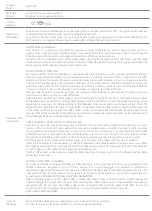
Copies of the I/B. Please reproduce them without any
changes except under special instruction from Team
International BELGIUM. The pages must be reproduced
and folded in order to obtain a booklet A5 (+/- 148.5 mm
width x 210 mm height). When folding, make sure you
keep the good numbering when you turn the pages of
the I/B. Don’t change the page numbering. Keep the
language integrity.
11
TKG BBA 2 – 080514
Assembly page 11/44
Fax +32 2 359 95 50
Water
It is recommended to use lukewarm drinking water. This gives the best results.
All-purpose flour
All-purpose flour is a blend of refined hard and soft wheat flours especially suited for making
breads and cakes. While this type of flour may give acceptable results from your bread maker,
we recommend using bread flour.
Bread flour
Bread flour is high gluten/protein flour that has been treated with conditioners that give dough
a greater tolerance during kneading. Bread flour typically has a higher gluten concentration
than all-purpose flour, however, depending on different milling practices this may vary. Bread
flour is recommended for use with this bread maker, but all-purpose flour will give acceptable
results.
Whole-wheat flour
Whole wheat flour is milled from the entire wheat kernel, which contains the bran and germ
and makes it heavier and richer in nutrients than all-purpose flour. Bread made with this flour is
usually smaller and heavier than white loaves. To overcome this, whole-wheat flour is usually
mixed with all-purpose flour, bread flour or gluten to produce taller, light-textured bread.
Rye flour
Rye flour is a high fibre flour similar to whole-wheat flour. Rye flour must always be mixed with a
high proportion of all-purpose flour, bread flour or gluten, as it does not contain enough gluten
to develop the structure for a tall, even-grained loaf.
Gluten
Gluten is the protein in the wheat that makes the dough elastic. Gluten is usually available at
most health food and bulk stores and is sometimes used in small portions with dense, low gluten
flours such as a whole-wheat to increase volume and lighten texture.
Cake flour
Cake flour is low gluten/protein flour and is specially designed for use in cake recipes. It is not
recommended for bread recipes.
Self-rising flour
Self-rising flours contain unnecessary leavening ingredients that will interfere with bread and
cake making. It is not recommended for use in your bread maker.
Bran
Bran (unprocessed) and wheat germ are the coarse outer portions of the wheat or rye grains
separated from the flour. They are often added in small quantities to bread for nutritional
enrichment, heartiness and flavour. They are also used to enhance the texture of bread.
Cornmeal and oatmeal
Cornmeal and oatmeal come from the coarsely ground white or yellow corn and from rolled
or steel-cut oats. They are used primarily to enhance the flavour and texture of bread.
Cracked wheat
Cracked wheat is very coarse in texture. It comes from wheat kernels cut into angular
fragments. It gives whole grain bread a nutty flavour and crunchy texture.
Seven-grain cereal blend
Seven-grain cereal blend is a blend of cracked wheat, oats, bran, rye, cornmeal, flax seeds
and hulled millet.











































